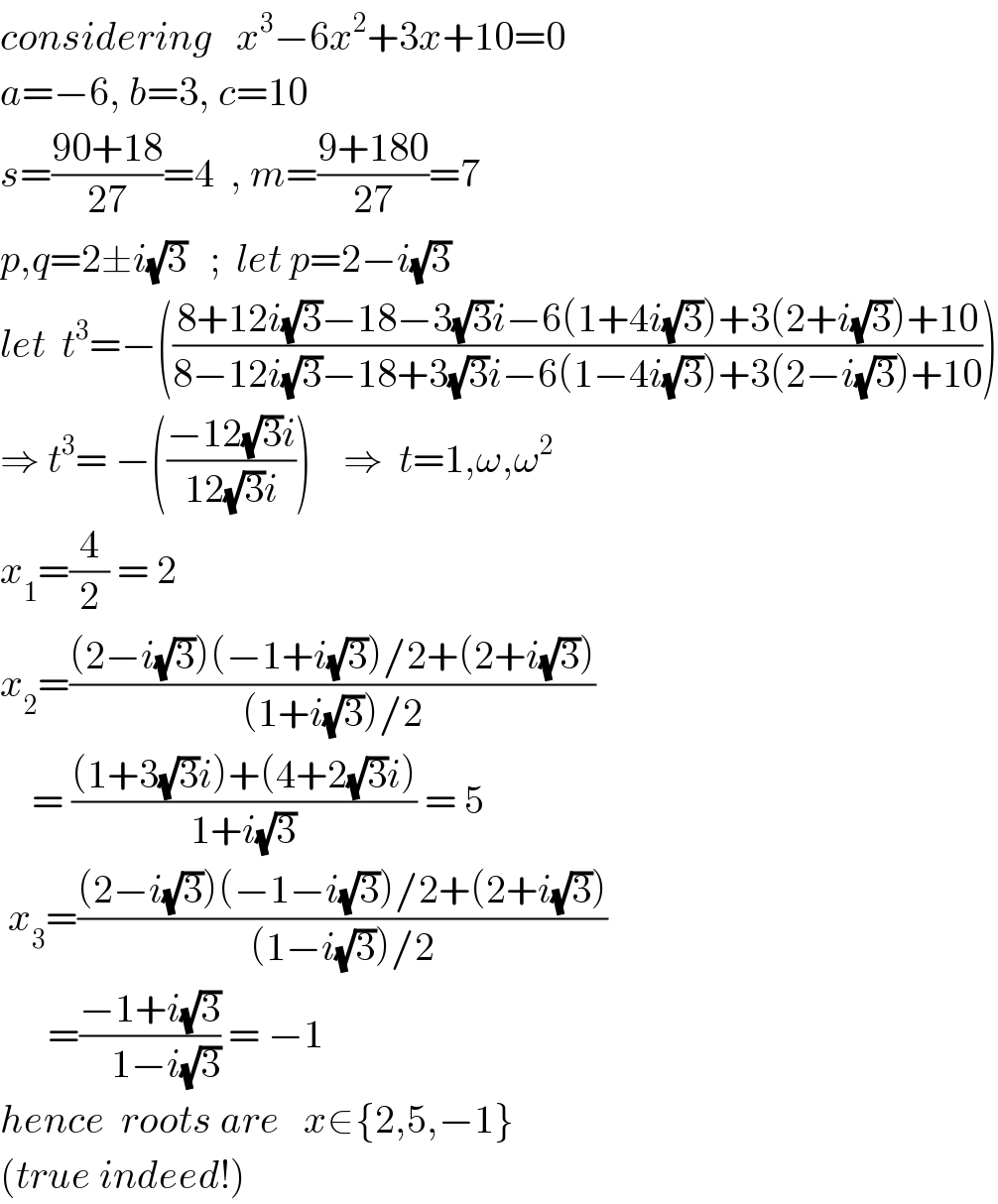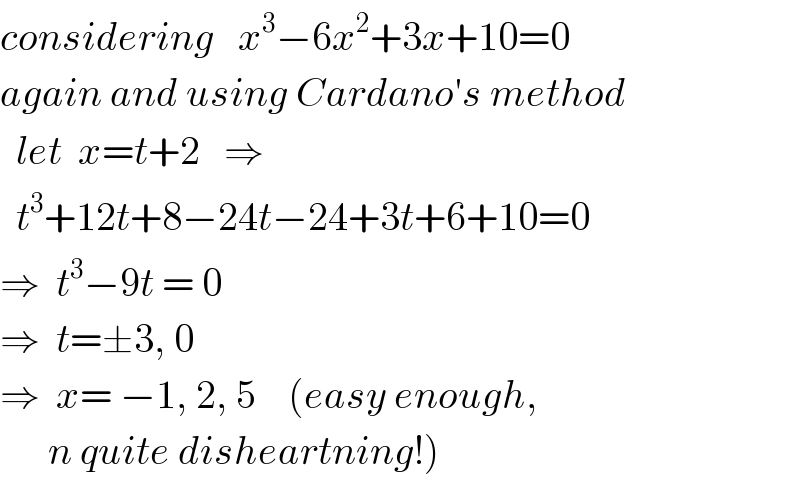Question Number 74339 by ajfour last updated on 22/Nov/19

$${x}^{\mathrm{3}} +{ax}^{\mathrm{2}} +{bx}+{c}=\mathrm{0} \\ $$$${Let}\:\:\:{x}=\frac{{pt}+{q}}{{t}+\mathrm{1}} \\ $$$${p}^{\mathrm{3}} {t}^{\mathrm{3}} +\mathrm{3}{p}^{\mathrm{2}} {qt}^{\mathrm{2}} +\mathrm{3}{pq}^{\mathrm{2}} {t}+{q}^{\mathrm{3}} \\ $$$$+{a}\left({t}+\mathrm{1}\right)\left({p}^{\mathrm{2}} {t}^{\mathrm{2}} +\mathrm{2}{pqt}+{q}^{\mathrm{2}} \right) \\ $$$$+{b}\left({pt}+{q}\right)\left({t}^{\mathrm{2}} +\mathrm{2}{t}+\mathrm{1}\right) \\ $$$$+{c}\left({t}^{\mathrm{3}} +\mathrm{3}{t}^{\mathrm{2}} +\mathrm{3}{t}+\mathrm{1}\right)\:\:\:\:=\:\:\mathrm{0} \\ $$$$\Rightarrow \\ $$$$\:\:\left({p}^{\mathrm{3}} +{ap}^{\mathrm{2}} +{bp}+{c}\right){t}^{\mathrm{3}} \\ $$$$+\left(\mathrm{3}{p}^{\mathrm{2}} {q}+{ap}^{\mathrm{2}} +\mathrm{2}{apq}+{bq}+\mathrm{2}{bp}+\mathrm{3}{c}\right){t}^{\mathrm{2}} \\ $$$$+\left(\mathrm{3}{q}^{\mathrm{2}} {p}+{aq}^{\mathrm{2}} +\mathrm{2}{apq}+{bp}+\mathrm{2}{bq}+\mathrm{3}{c}\right){t} \\ $$$$+\left({q}^{\mathrm{3}} +{aq}^{\mathrm{2}} +{bq}+{c}\right)\:=\:\mathrm{0} \\ $$$${Let}\:{coeffs}.\:{of}\:{t}^{\mathrm{2}} \:{and}\:{t}\:{be}\:{zero}. \\ $$$${Subtracting}\:{and}\:{adding}\:{them} \\ $$$$\:\mathrm{3}{pq}+{a}\left({p}+{q}\right)+{b}=\mathrm{0}\:\:\:\& \\ $$$$\mathrm{3}{pq}\left({p}+{q}\right)+{a}\left\{\left({p}+{q}\right)^{\mathrm{2}} −\mathrm{2}{pq}\right\} \\ $$$$\:+\mathrm{4}{apq}+\mathrm{3}{b}\left({p}+{q}\right)+\mathrm{6}{c}\:=\:\mathrm{0} \\ $$$${lets}\:{call}\:\:{pq}={m}\:,\:\:{p}+{q}={s}\:\:\Rightarrow \\ $$$$\:\:\mathrm{3}{m}+{as}+{b}=\mathrm{0}\:\:\:\:….\left({i}\right) \\ $$$$\mathrm{3}{ms}+{a}\left({s}^{\mathrm{2}} −\mathrm{2}{m}\right)+\mathrm{4}{am}+\mathrm{3}{bs}+\mathrm{6}{c}=\mathrm{0} \\ $$$$\Rightarrow\:{am}+{bs}+\mathrm{3}{c}=\mathrm{0}\:\:\:\:….\left({ii}\right) \\ $$$$\Rightarrow\:\:{s}=\frac{\mathrm{9}{c}−{ab}}{{a}^{\mathrm{2}} −\mathrm{3}{b}}\:\:\:;\:\:{m}=\frac{{b}^{\mathrm{2}} −\mathrm{3}{ac}}{{a}^{\mathrm{2}} −\mathrm{3}{b}} \\ $$$$\:{Now}\:\:{p},{q}\:\:{are}\:{roots}\:{of}\:{eq}. \\ $$$$\:\:\:{z}^{\mathrm{2}} −{sz}+{m}=\mathrm{0} \\ $$$$\:\:\:{p},{q}\:=\:\frac{{s}}{\mathrm{2}}\pm\sqrt{\frac{{s}^{\mathrm{2}} }{\mathrm{4}}−{m}} \\ $$$$\:\:{t}^{\mathrm{3}} =−\left(\frac{{q}^{\mathrm{3}} +{aq}^{\mathrm{2}} +{bq}+{c}}{{p}^{\mathrm{3}} +{ap}^{\mathrm{2}} +{bq}+{c}}\right)\:\:\:\:\:\left({t}\neq−\mathrm{1}\right) \\ $$$$\:\:\:{x}=\frac{{pt}+{q}}{{t}+\mathrm{1}}\:. \\ $$
Commented by ajfour last updated on 23/Nov/19

$${considering}\:\:\:{x}^{\mathrm{3}} −\mathrm{6}{x}^{\mathrm{2}} +\mathrm{3}{x}+\mathrm{10}=\mathrm{0} \\ $$$${a}=−\mathrm{6},\:{b}=\mathrm{3},\:{c}=\mathrm{10} \\ $$$${s}=\frac{\mathrm{90}+\mathrm{18}}{\mathrm{27}}=\mathrm{4}\:\:,\:{m}=\frac{\mathrm{9}+\mathrm{180}}{\mathrm{27}}=\mathrm{7} \\ $$$${p},{q}=\mathrm{2}\pm{i}\sqrt{\mathrm{3}}\:\:\:;\:\:{let}\:{p}=\mathrm{2}−{i}\sqrt{\mathrm{3}} \\ $$$${let}\:\:{t}^{\mathrm{3}} =−\left(\frac{\mathrm{8}+\mathrm{12}{i}\sqrt{\mathrm{3}}−\mathrm{18}−\mathrm{3}\sqrt{\mathrm{3}}{i}−\mathrm{6}\left(\mathrm{1}+\mathrm{4}{i}\sqrt{\mathrm{3}}\right)+\mathrm{3}\left(\mathrm{2}+{i}\sqrt{\mathrm{3}}\right)+\mathrm{10}}{\mathrm{8}−\mathrm{12}{i}\sqrt{\mathrm{3}}−\mathrm{18}+\mathrm{3}\sqrt{\mathrm{3}}{i}−\mathrm{6}\left(\mathrm{1}−\mathrm{4}{i}\sqrt{\mathrm{3}}\right)+\mathrm{3}\left(\mathrm{2}−{i}\sqrt{\mathrm{3}}\right)+\mathrm{10}}\right) \\ $$$$\Rightarrow\:{t}^{\mathrm{3}} =\:−\left(\frac{−\mathrm{12}\sqrt{\mathrm{3}}{i}}{\mathrm{12}\sqrt{\mathrm{3}}{i}}\right)\:\:\:\:\Rightarrow\:\:{t}=\mathrm{1},\omega,\omega^{\mathrm{2}} \\ $$$${x}_{\mathrm{1}} =\frac{\mathrm{4}}{\mathrm{2}}\:=\:\mathrm{2}\:\:\:\: \\ $$$${x}_{\mathrm{2}} =\frac{\left(\mathrm{2}−{i}\sqrt{\mathrm{3}}\right)\left(−\mathrm{1}+{i}\sqrt{\mathrm{3}}\right)/\mathrm{2}+\left(\mathrm{2}+{i}\sqrt{\mathrm{3}}\right)}{\left(\mathrm{1}+{i}\sqrt{\mathrm{3}}\right)/\mathrm{2}} \\ $$$$\:\:\:\:=\:\frac{\left(\mathrm{1}+\mathrm{3}\sqrt{\mathrm{3}}{i}\right)+\left(\mathrm{4}+\mathrm{2}\sqrt{\mathrm{3}}{i}\right)}{\mathrm{1}+{i}\sqrt{\mathrm{3}}}\:=\:\mathrm{5} \\ $$$$\:{x}_{\mathrm{3}} =\frac{\left(\mathrm{2}−{i}\sqrt{\mathrm{3}}\right)\left(−\mathrm{1}−{i}\sqrt{\mathrm{3}}\right)/\mathrm{2}+\left(\mathrm{2}+{i}\sqrt{\mathrm{3}}\right)}{\left(\mathrm{1}−{i}\sqrt{\mathrm{3}}\right)/\mathrm{2}} \\ $$$$\:\:\:\:\:\:=\frac{−\mathrm{1}+{i}\sqrt{\mathrm{3}}}{\:\:\:\:\mathrm{1}−{i}\sqrt{\mathrm{3}}}\:=\:−\mathrm{1}\: \\ $$$${hence}\:\:{roots}\:{are}\:\:\:{x}\in\left\{\mathrm{2},\mathrm{5},−\mathrm{1}\right\} \\ $$$$\left({true}\:{indeed}!\right)\:\:\:\:\:\:\: \\ $$
Commented by ajfour last updated on 23/Nov/19

$${considering}\:\:\:{x}^{\mathrm{3}} −\mathrm{6}{x}^{\mathrm{2}} +\mathrm{3}{x}+\mathrm{10}=\mathrm{0} \\ $$$${again}\:{and}\:{using}\:{Cardano}'{s}\:{method} \\ $$$$\:\:{let}\:\:{x}={t}+\mathrm{2}\:\:\:\Rightarrow \\ $$$$\:\:{t}^{\mathrm{3}} +\mathrm{12}{t}+\mathrm{8}−\mathrm{24}{t}−\mathrm{24}+\mathrm{3}{t}+\mathrm{6}+\mathrm{10}=\mathrm{0} \\ $$$$\Rightarrow\:\:{t}^{\mathrm{3}} −\mathrm{9}{t}\:=\:\mathrm{0} \\ $$$$\Rightarrow\:\:{t}=\pm\mathrm{3},\:\mathrm{0} \\ $$$$\Rightarrow\:\:{x}=\:−\mathrm{1},\:\mathrm{2},\:\mathrm{5}\:\:\:\:\left({easy}\:{enough},\right. \\ $$$$\left.\:\:\:\:\:\:{n}\:{quite}\:{disheartning}!\right) \\ $$
